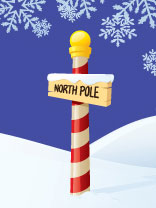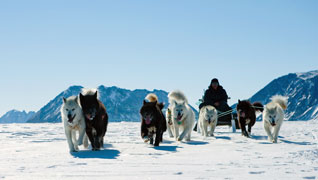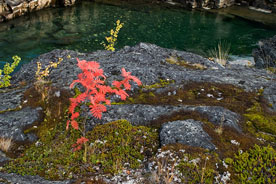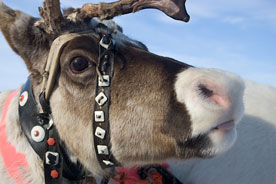
Arctic Map
Arctic Map > The Subarctic
 The Arctic region includes the area that lies north of the Arctic Circle,
which is situated about 66.7 degrees north of the Equator.
The North Pole, which is the northernmost point of the axis around which
the earth rotates, lies at the center of the Arctic region.
The Arctic region includes the area that lies north of the Arctic Circle,
which is situated about 66.7 degrees north of the Equator.
The North Pole, which is the northernmost point of the axis around which
the earth rotates, lies at the center of the Arctic region.
The North Pole is actually not on land. Instead, it is in the middle of the Arctic Ocean, which is dotted with many large and small islands and almost entirely surrounded by land. Many people think that the North Pole is on land because the sea there is frozen solid and accessible by foot.
Alaska is the first landmass of the Arctic region encountered as one moves east from the Bering Strait. Part of the United States since 1867, Alaska comprises 600,000 square miles and is the largest state. Some of Alaska's primary commodities include petroleum, natural gas, and coal, as well as timber and salmon.
Continuing eastward, the land becomes Canada. The Canadian Arctic comprises many islands, including Banks Island, Victoria Island, and the Queen Elizabeth Islands as well as Ellesmere and Baffin Islands. On the opposite shore of Baffin Bay, which curls around Baffin Island, is Greenland, a large island that belongs to Denmark. The Greenland Sea begins on the east side of this island. The Greenland Sea turns into the Norway Sea, which is studded with several islands belonging to Norway.
Moving eastward, the northernmost tips of Norway, Sweden, and Finland are located in the Arctic Circle. Next comes Russia which, when following the Arctic Circle, is so large that it extends almost halfway around the world. The Barents Sea, the Kara Sea, and the Laptev Sea lie between the mainland coast of Russia and the North Pole. Many islands dot these seas.

The Arctic region's reputation for having a harsh environment is very well-deserved. In winter, when temperatures can fall to -70 degrees Celsius and harsh winds batter the land, it is so cold that large areas of the ocean freeze solid.
While much of the Arctic is too harsh to support trees, and very few plants are in evidence, areas in the southern sub-Arctic regions are home to many species of trees, plants, and flowers during the warmer summer months.
Animal species that are able to survive in the Arctic are often vast in number, and include caribou, muskox, lemming, hare, and Arctic fox. Much of the ice melts in the summer, and the region warms up enough to support some additional species of animals, including whales, dolphins, foxes, bears, and sea birds.
The Arctic Frontier
For an outline map and more information about the Arctic, visit the CIA World Factbook Arctic Ocean page. For in-depth scientific and general interest information about the Arctic, as well as frequently asked questions and answers about this fascinating part of our planet, visit the NOAA Arctic Theme Page.Bibliography
- Dowdeswell, J. A. and Hambrey, M. J. (2002). Islands of the Arctic. Cambridge, United Kingdom: Cambridge University Press.
- Hook, P. (2006). The Frozen World. London: Compendium Publishing.
- Sale, R. (2006). A Complete Guide to Arctic Wildlife. Buffalo, New York: Firefly Books.

